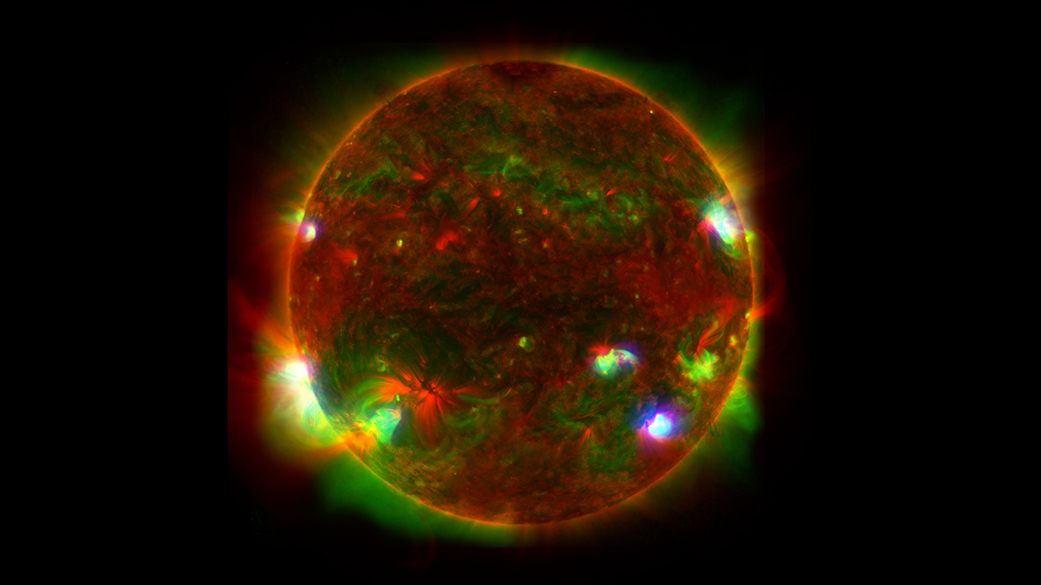Insider Brief:
- NASA’s Nuclear Spectroscopic Telescope Array (NuSTAR) provided new insights about our star.
- High-energy X-rays observed by NuSTAR appear at only a few locations in the Sun’s atmosphere.
- NuSTAR’s view could help scientists understand why the Sun’s outer atmosphere, reaches more than a million degrees – at least 100 times hotter than its surface.
PRESS RELEASE — February 10, 2023 – Some of the hottest spots in the Sun’s atmosphere appear in the telescope’s X-ray view.
Even on a sunny day, human eyes can’t see all the light our nearest star gives off. A new image displays some of this hidden light, including the high-energy X-rays emitted by the hottest material in the Sun’s atmosphere, as observed by NASA’s Nuclear Spectroscopic Telescope Array (NuSTAR). While the observatory typically studies objects outside our solar system – like massive black holes and collapsed stars – it has also provided astronomers with insights about our Sun.
In the composite image above, NuSTAR data is represented as blue and is overlaid with observations by the X-ray Telescope (XRT) on the Japanese Aerospace Exploration Agency’s Hinode mission, represented as green, and the Atmospheric Imaging Assembly (AIA) on NASA’s Solar Dynamics Observatory (SDO), represented as red. NuSTAR’s relatively small field of view means it can’t see the entire Sun from its position in Earth orbit, so the observatory’s view of the Sun is actually a mosaic of 25 images, taken in June 2022.
The high-energy X-rays observed by NuSTAR appear at only a few locations in the Sun’s atmosphere. By contrast, Hinode’s XRT detects low-energy X-rays, and SDO’s AIA detects ultraviolet light – wavelengths that are emitted across the entire face of the Sun.
NuSTAR’s view could help scientists solve one of the biggest mysteries about our nearest star: why the Sun’s outer atmosphere, called the corona, reaches more than a million degrees – at least 100 times hotter than its surface. This has puzzled scientists because the Sun’s heat originates in its core and travels outward. It’s as if the air around a fire were 100 times hotter than the flames.
The source of the corona’s heat could be small eruptions in the Sun’s atmosphere called nanoflares. Flares are large outbursts of heat, light, and particles visible to a wide range of solar observatories. Nanoflares are much smaller events, but both types produce material even hotter than the average temperature of the corona. Regular flares don’t happen often enough to keep the corona at the high temperatures scientists observe, but nanoflares may occur much more frequently – perhaps often enough that they collectively heat the corona.
Although individual nanoflares are too faint to observe amid the Sun’s blazing light, NuSTAR can detect light from the high-temperature material thought to be produced when a large number of nanoflares occur close to one another. This ability enables physicists to investigate how frequently nanoflares occur and how they release energy.
The observations used in these images coincided with the 12th close approach to the Sun, or perihelion, by NASA’s Parker Solar Probe, which is flying closer to the our star than any other spacecraft in history. Taking observations with NuSTAR during one of Parker’s perihelion passes enables scientists to link activity observed remotely in the Sun’s atmosphere with the direct samples of the solar environment taken by the probe.
More About the Mission
NuSTAR launched on June 13, 2012. A Small Explorer mission led by Caltech in Pasadena, California, and managed by JPL for NASA’s Science Mission Directorate in Washington, it was developed in partnership with the Danish Technical University (DTU) and the Italian Space Agency (ASI). The telescope optics were built by Columbia University, NASA’s Goddard Space Flight Center in Greenbelt, Maryland, and DTU. The spacecraft was built by Orbital Sciences Corp. in Dulles, Virginia. NuSTAR’s mission operations center is at the University of California, Berkeley, and the official data archive is at NASA’s High Energy Astrophysics Science Archive Research Center. ASI provides the mission’s ground station and a mirror data archive. Caltech manages JPL for NASA.
For more information on NuSTAR, visit: www.nustar.caltech.edu.
Contact Information:
Calla Cofield
Jet Propulsion Laboratory, Pasadena, Calif.
626-808-2469
[email protected]
SOURCE: NASA
Featured image: Wavelengths of light from three space observatories are overlapped to provide a unique view of the Sun in the image at left. The high-energy X-ray light detected by one of those observatories, NASA’s NuSTAR, is seen isolated at right; a grid was added to indicate the Sun’s surface. Credit: NASA / JPL-Caltech / JAXA
If you found this article to be informative, you can explore more current space industry news, exclusives, interviews, and podcasts.
Share this article:










